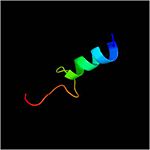Mycobacterium tuberculosis ArfA Rv0899
From Proteopedia
Structural highlights
Structure SectionThe 326-residue Rv0899 ArfA protein from Mycobacterium tuberculosis [1] contains three domains: an N-terminal domain (residues 1-72) that includes a sequence of 20 hydrophobic amino acids required for membrane translocation. Residues form a mixed alpha/beta-globular structure, encompassing two independently folded modules corresponding to the B and C domains connected by a flexible linker. The central B domain ( ) folds with . The B domain has homology with conserved putative [2]. . The C domain has homology to the OmpA-C-like superfamily of periplasmic peptidoglycan-binding sequences, found in several types of bacterial membrane proteins.The C domain of wild-type ArfA folds into .[1] FunctionThe membrane protein Rv0899 ArfA belongs to the OmpA (outer membrane protein A) family of outer membrane proteins and has been proposed to act as an outer membrane porin and to contribute to the bacterium's adaptation to the acidic environment of the phagosome[3] during infection.The deletion of this gene impairs the uptake of some water-soluble substances, such as serine, glucose, and glycerol. Using NMR chemical shift perturbation and isothermal calorimetric titration assays, Rv0899 was able to interact with , which may indicate a role for Rv0899 in the process of Zn(2+) acquisition. [2] Mycobacterium tuberculosis ArfA (Rv0899) is a membrane protein encoded by an ammonia release facilator operon that is necessary for rapid ammonia secretion, pH neutralization and adaptation to acidic environments in vitro. Its C-terminal domain (C domain) shares significant sequence homology with the OmpA-like family of peptidoglycan-binding domains, suggesting that its physiological function in acid stress protection may be related to its interaction with the mycobacterial cell wall. It exhibits pH-dependent conformational dynamics (with significant heterogeneity at neutral pH and a more ordered structure at acidic pH), which could be related to its acid stress response. The C domain associates tightly with polymeric peptidoglycan isolated from Mycobacterium tuberculosis. Its functions in acid stress protection and suggest a link between the acid stress response and the physicochemical properties of the mycobacterial cell wall .[3].
DiseaseThe protein Rv0899 ArfA is restricted to pathogenic Mycobacteria associated with Tuberculosis and, thus, is an attractive candidate for the development of anti-Tuberculosis chemotherapeutic agents.Two M. tuberculosis H37Rv genes (Rv0900 and Rv0901) adjacent to Rv0899 also encode putative membrane proteins, and are found exclusively in association with Rv0899 in the same pathogenic mycobacteria, suggesting that the three may constitute an operon dedicated to a common function. The ompATb operon is necessary for rapid ammonia secretion and adaptation of M. tuberculosis to acidic environments in vitro but not in mice. [4] The amino acid pair ,located at the end of α1 and preceding L3, undergoes in-vitro deamidation, a pH-dependent reaction whereby Asn is converted to Asp and ammonia is released. Asparagine residues preceding glycine, and situated in conformationally flexible regions of proteins, are frequently deamidated, with potentially significant consequences for protein regulation and function. In the case of Rv0899, deamidation and the concomitant release of ammonia could have important consequences for the acid adaptation function of the protein. [5]
RelevanceProbably plays a role in ammonia secretion that neutralizes the medium at pH 5.5,and preceded exponential growth of Mycobacterium tuberculosis, although it does not play a direct role in ammonia transport.[ARFA_MYCTU]. References
| ||||||||||||||||


